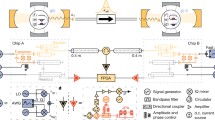Abstract
We present a method of performing quantum state transfer in a chain of superconducting quantum bits. Our protocol is based on engineering the energy levels of the qubits in the chain and tuning them all simultaneously with an external flux bias. The system is designed to allow sequential adiabatic state transfers, resulting in on-demand quantum state transfer from one end of the chain to the other. Numerical simulations of the master equation using realistic parameters for capacitive nearest-neighbor coupling, energy relaxation, and dephasing show that fast, high-fidelity state transfer should be feasible using this method.





Similar content being viewed by others
References
Barends, R., Kelly, J., Megrant, A., Sank, D., Jeffrey, E., Chen, Y., Yin, Y., Chiaro, B., Mutus, J., Neill, C., OMalley, P., Roushan, P., Wenner, J., White, T.C., Cleland, A.N., Martinis, J.M.: Coherent Josephson qubit suitable for scalable quantum integrated circuits. Phys. Rev. Lett. 111(8), 080,502 (2013). doi:10.1103/PhysRevLett.111.080502
Blais, A., Gambetta, J., Wallraff, A., Schuster, D., Girvin, S., Devoret, M., Schoelkopf, R.: Quantum-information processing with circuit quantum electrodynamics. Phys. Rev. A 75(3), 1–21 (2007). doi:10.1103/PhysRevA.75.032329
Bose, S.: Quantum communication through an unmodulated spin chain. Phys. Rev. Lett. 91(20), 207,901 (2003). doi:10.1103/PhysRevLett.91.207901
Bose, S.: Quantum communication through spin chain dynamics: an introductory overview. Contemp. Phys. 48(1), 13–30 (2007). doi:10.1080/00107510701342313
Córcoles, A.D., Magesan, E., Srinivasan, S.J., Cross, A.W., Steffen, M., Gambetta, J.M., Chow, J.M.: Demonstration of a quantum error detection code using a square lattice of four superconducting qubits. Nat. Commun. 6, 6979 (2015). doi:10.1038/ncomms7979
Devoret, M.H.: Quantum Fluctuations in Electrical Circuits. Elsevier, New York (1997)
Devoret, M.H., Schoelkopf, R.J.: Superconducting circuits for quantum information: an outlook. Science 339(6124), 1169–1174 (2013). doi:10.1126/science.1231930
DiCarlo, L., Chow, J.M., Gambetta, J.M., Bishop, L.S., Johnson, B.R., Schuster, D.I., Majer, J., Blais, A., Frunzio, L., Girvin, S.M., Schoelkopf, R.J.: Demonstration of two-qubit algorithms with a superconducting quantum processor. Nature 460(7252), 240–244 (2009). doi:10.1038/nature08121
Eckert, K., Romero-Isart, O., Sanpera, A.: Efficient quantum state transfer in spin chains via adiabatic passage. New J. Phys. 9(5), 155–155 (2007). doi:10.1088/1367-2630/9/5/155
Fedorov, A., Feofanov, A.K., MacHa, P., Forn-Díaz, P., Harmans, C.J.P.M., Mooij, J.E.: Strong coupling of a quantum oscillator to a flux qubit at its symmetry point. Phys. Rev. Lett. 105(6), 060,503 (2010). doi:10.1103/PhysRevLett.105.060503
Frisk Kockum, A.: Modelling spectroscopy on transmon qubits in an undercoupled resonator. M.Sc thesis, Chalmers University of Technology (2010)
Gambetta, J.M., Houck, A.A., Blais, A.: Superconducting qubit with purcell protection and tunable coupling. Phys. Rev. Lett. 106(3), 030,502 (2011). doi:10.1103/PhysRevLett.106.030502
Houck, A.A., Koch, J., Devoret, M.H., Girvin, S.M., Schoelkopf, R.J.: Life after charge noise: recent results with transmon qubits. Quantum Inf. Process. 8(2–3), 105–115 (2009). doi:10.1007/s11128-009-0100-6
Kelly, J., Barends, R., Fowler, A.G., Megrant, A., Jeffrey, E., White, T.C., Sank, D., Mutus, J.Y., Campbell, B., Chen, Y., Chen, Z., Chiaro, B., Dunsworth, A., Hoi, I.C., Neill, C., OMalley, P.J.J., Quintana, C., Roushan, P., Vainsencher, A., Wenner, J., Cleland, A.N., Martinis, J.M.: State preservation by repetitive error detection in a superconducting quantum circuit. Nature 519(7541), 66–69 (2015). doi:10.1038/nature14270
Koch, J., Yu, T., Gambetta, J., Houck, A., Schuster, D., Majer, J., Blais, A., Devoret, M., Girvin, S., Schoelkopf, R.: Charge-insensitive qubit design derived from the Cooper pair box. Phys. Rev. A 76(4), 042,319 (2007). doi:10.1103/PhysRevA.76.042319
Koch, R.H., Keefe, G.A., Milliken, F.P., Rozen, J.R., Tsuei, C.C., Kirtley, J.R., Divincenzo, D.P.: Experimental demonstration of an oscillator stabilized josephson flux qubit. Phys. Rev. Lett. 96(12), 127,001 (2006). doi:10.1103/PhysRevLett.96.127001
Kockum, A.F., Sandberg, M., Vissers, M.R., Gao, J., Johansson, G., Pappas, D.P.: Detailed modelling of the susceptibility of a thermally populated, strongly driven circuit-QED system. J. Phys. B At. Mol. Opt. Phys. 46(22), 224014 (2013)
Lucero, E., Barends, R., Chen, Y., Kelly, J., Mariantoni, M., Megrant, A., OMalley, P., Sank, D., Vainsencher, A., Wenner, J., White, T., Yin, Y., Cleland, A.N., Martinis, J.M.: Computing prime factors with a Josephson phase qubit quantum processor. Nat. Phys. 8, 719–723 (2012). doi:10.1038/nphys2385
Lyakhov, A., Bruder, C.: Use of dynamical coupling for improved quantum state transfer. Phys. Rev. B 74(23), 235,303 (2006). doi:10.1103/PhysRevB.74.235303
Oskin, M., Chong, F.T., Chuang, I.L., Kubiatowicz, J.: Building Quantum Wires: The Long and the Short of it. Proceedings of the 30th annual international symposium on computer architecture (ISCA’03), pp. 374–385 (2003)
Paik, H., Schuster, D., Bishop, L., Kirchmair, G., Catelani, G., Sears, A., Johnson, B., Reagor, M., Frunzio, L., Glazman, L., Girvin, S., Devoret, M., Schoelkopf, R.: Observation of high coherence in Josephson junction qubits measured in a three-dimensional circuit QED architecture. Phys. Rev. Lett. 107(24), 240501 (2011). doi:10.1103/PhysRevLett.107.240501
Reed, M.D., DiCarlo, L., Nigg, S.E., Sun, L., Frunzio, L., Girvin, S.M., Schoelkopf, R.J.: Realization of three-qubit quantum error correction with superconducting circuits. Nature 482(7385), 382–385 (2012). doi:10.1038/nature10786
Romito, A., Fazio, R., Bruder, C.: Solid-state quantum communication with Josephson arrays. Phys. Rev. B 71(10), 100,501 (2005). doi:10.1103/PhysRevB.71.100501
Schwarz, M.J., Goetz, J., Jiang, Z., Niemczyk, T., Deppe, F., Marx, A., Gross, R.: Gradiometric flux qubits with a tunable gap. New J. Phys. 15, 045,001 (2013)
Acknowledgments
The authors would like to acknowledge support from the Laboratory for Physical Sciences, IARPA, and the Joint Quantum Institute. This work is property of the US Government and not subject to copyright.
Author information
Authors and Affiliations
Corresponding author
Appendix
Appendix
Here we derive our expressions for nearest-neighbor coupling of the transmon qubits. We start from the circuit shown in Fig. 1b. The input and output terminals are the points that connect the Josephson junctions (\(J_1\) and \(J_2\)) to the circuit. We select \(J_1\) to be the input and \(J_2\) the output. We remove the shunting capacitances \(C_{12}\) and \(C_{34}\), since these can be viewed as part of the source (load) impedance and concentrate on the coupling network. The equivalent open output voltage \(V_\mathrm{out}^T\) is given by the expression
We then short circuit the output and calculate the shorting current
Instead of rewriting the source voltage as \(V_\mathrm{out}^T\) as is done in the standard Thevenin equivalent we follow the example in appendix A of Ref. [15] and introduce a shunt capacitance \(\tilde{C}_{B2}\) to the output and keep the source voltage to be \(V_\mathrm{in}\). The circuit now consists of a source at voltage \(V_\mathrm{in}\), an impedance in series with the source and a shunt impedance, parallel with the output. The series impedance gives the condition
We then find the shunt impedance from voltage division by requiring that across the shunt impedance should be \(V_\mathrm{out}\) derived above. This gives an expression for a shunt capacitance \(\tilde{C}_{B2}\):
Changing the input and output sides we can also introduce a shunt capacitance on the input \(\tilde{C}_{B1}\). We define new shunt capacitance by reintroducing the source (load) capacitance \(C_{12}\) (\(C_{34}\)) so that \(C_{B1}=\tilde{C}_{B1}+C_{12}\) and \(C_{B2}=\tilde{C}_{B2}+C_{34}\). The capacitive network now consists of three capacitances \(C_\mathrm{in}\), \(C_{B1}\) and \(C_{B2}\) in a \(\pi \)- circuit. We now introduce the node fluxes \(\varPhi _1\) and \(\varPhi _2\) at the each side of the coupling capacitance \(C_c\) branch. As a first step in quantizing the circuit (see Ref. [6]) we write down the Lagrangian:
We then get the classical Hamiltonian through the standard Legendre transformation by expressing \(\dot{\varPhi }_1\) and \(\dot{\varPhi }_2\) as
where \(p_1\) and \(p_2\) are the canonical momentum:
To get the quantum mechanical Hamiltonian we replace \( \varPhi _{1,2}\) and \(p_{1,2}\) with the quantum mechanical operators \(\hat{\varPhi }_{1,2}\) and \(\hat{p}_{1,2}\) that obey the commutation relations
where \(\delta _{n,m}\) is Kronecker’s delta. We now introduce the Cooper-pair number operator defined as \(\hat{n}_i=\hat{p}_i/2\mathrm {e}\). This allows us to write down the Hamiltonian shown in Eq. 2. In that expression we have defined the charging energies \(E_{CC}\), \(E_{C1}\) and \(E_{C2}\) in the re-normalized capacitances:
obtained by collecting the terms for \(\hat{n}_1\hat{n}_2\), \(\hat{n}_1^2\) and \(\hat{n}_2^2\), respectively. We see that if we let \(C_c \rightarrow 0\) we retain the expression for two uncoupled transmon qubits. These expressions can in the same manner be extended to the case where each qubit has two nearest neighbors.
Rights and permissions
About this article
Cite this article
Sandberg, M., Knill, E., Kapit, E. et al. Efficient quantum state transfer in an engineered chain of quantum bits. Quantum Inf Process 15, 1213–1224 (2016). https://doi.org/10.1007/s11128-015-1152-4
Received:
Accepted:
Published:
Issue Date:
DOI: https://doi.org/10.1007/s11128-015-1152-4




